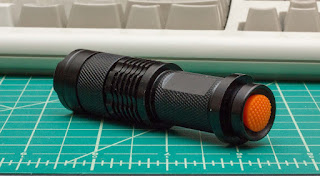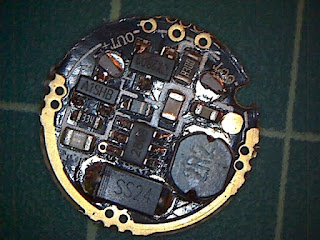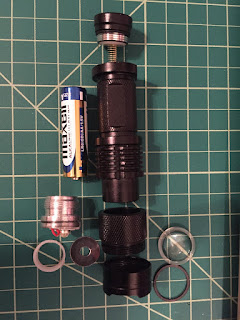These lights are very cheap, take a single AA battery, but surprisingly they work very well. I have many of these around my house for when the power goes out. They are small, focusable, great battery life, and put off a good amount of light. For the price, I have nothing bad to say about these lights and I recommend buying them.
But here's a simple teardown of one.
First off, here's the light in all it's glory. Measuring 94mm at it's length and 26mm at its thickest point.
The button at the back is a simple on/off click button. The light itself has 3 different modes. A high, low, and flashing setting. Clicking the light on and off or pushing the button part way allows you to switch between modes.
You can unscrew a ring on the front and remove an O-ring and lens.
You can see in the above photo there are two opposing notches in the silver part of the reflector towards the outside. But using my caliper I was I able to insert the caliper edges in to those slots and unscrew the unit from its housing on the main body.
I wasn't too sure where to go from here and thought maybe the led unit was all glued together. But then I kept messing around with it and was able to remove that plastic ring and reflector bit. This then exposed the led module. The led is a Cree XR-E or XR-C (probably the lower model XR-C) from what I could look up. There's not any specific model identifying information but it does look like one of those two models. Cree makes a good led so this is nice. From my testing, this led seems to be the best at 3 volts and 400 ma current draw.
Now when I removed the led, I noticed some circuitry behind it. This wasn't what I was expecting to see there. I figured the led was going to be the only thing at the front and the circuitry was going to be in that clicky switch in the back. Nope, all the circuitry and driver was right behind the led.
And that's that. Overall these are great little lights for the price.

































